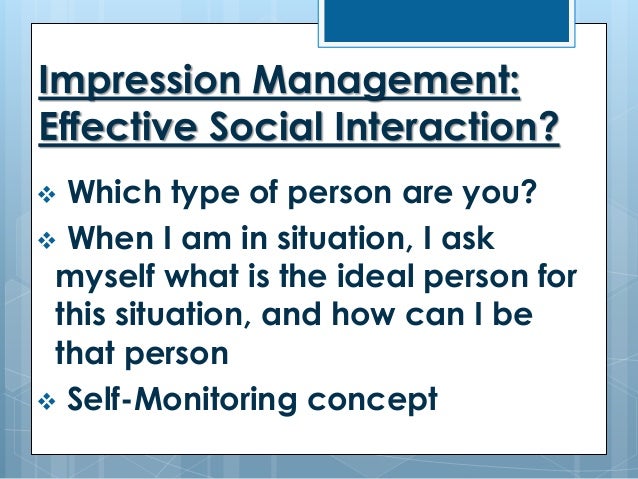

We achieve this purpose by having a collective “definition of the situation,” where all agree on an expected outcome defining how everyone should behave. This page uses Creative Commons Licensed content from Wikipedia ( view authors).What it’s about: The central idea of this classical work of sociology is that people are constantly engaged in a process of “impression management” to project a favorable view of themselves. Impression management can distort the results of empirical research that relies on interviews and surveys. While an actor (speaker) tries to project a desired image, an audience (listener) might attribute a resonant or discordant image. IM style norms, part of the mental programming received through socialization, are so fundamental that we usually do not notice our expectations of them. Another factor in impression management is self-verification, the act of conforming the audience to the person's self-concept. These differences in response towards the environment and target audience is called self-monitoring.

In addition to these goals, individuals differ in responses from the interactional environment, some may be irresponsive to audience's reactions while others actively respond to audience reactions in order to elicit positive results. The objective of the performance is to provide the audience with an impression consistent with the desired goals of the actor (Barnhart, 1994). The actor, shaped by the environment and target audience, sees interaction as a performance. Goffman’s work is written from a symbolic interactionist perspective, emphasizing a qualitative analysis of the interactive nature of the communication process (Barnhart, 1994). Goffman presented Impression management dramaturgically, explaining the motivations behind complex human performances within a social setting based on a play metaphor (Dillard et al., 2000). Erving Goffman also followed in his seminal book The Presentation of Self in Everyday Life a dramaturgical analogy, in which he said, "All the world is not, of course, a stage, but the crucial ways in which it isn't are not easy to specify." Plato spoke of the "great stage of human life" and Shakespeare crafted the famous sentence "All the world is a stage, and all the men and women merely players" in the 17th century. Strategic interpersonal behavior to shape or influence impressions formed by an audience is not a new field it has a rich history. The idea that perception is reality is the basis for this sociological and social psychology theory, which is framed around the presumption that the other’s perceptions of you or your organization become the reality from which they form ideas and the basis for intended behaviors. This form of management generally applies to the first impression.

The goal is for one to present themselves the way in which they would like to be thought of by the individual or group they are interacting with. From both a communications and public relations viewpoint, the theory of impression management encompasses the vital ways in which one establishes and communicates this congruence between personal or organizational goals and their intended actions which create public perception. Impression management (IM) theory states that any individual or organization must establish and maintain impressions that are congruent with the perceptions they want to convey to their publics (Goffman, 1959). It is usually synonymous with self-presentation, if a person tries to influence the perception of their image. It is a goal-directed conscious or unconscious attempt to influence the perceptions of other people about a person, object or event by regulating and controlling information in social interaction. In sociology and social psychology, impression management is the process through which people try to control the impressions other people form of them.


 0 kommentar(er)
0 kommentar(er)
